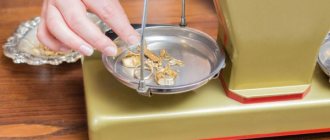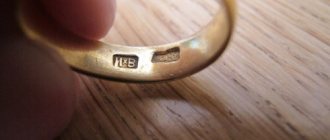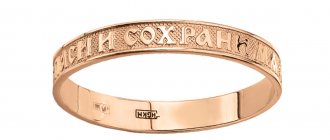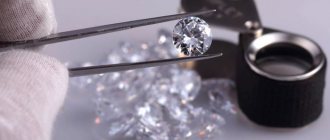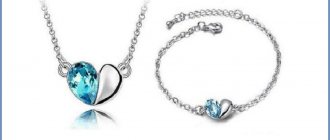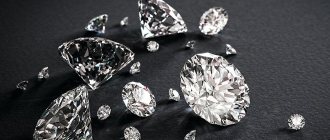Post updated: Jun 6, 2020
Today you can find a lot of fake jewelry. How to distinguish gold from fake so as not to become a victim of scammers? There are many effective ways. The most reliable method is to check with a specialist. If he is not nearby, then there are some useful tips from jewelers.
Ways to recognize fake jewelry
First you need to consider the jewelry. It must have a special marking that is responsible for the authenticity of the gold. The hallmark or carat weight must be stamped. To facilitate inspection, it is advisable to use a magnifying glass. It is not always possible to distinguish the mark on antique metal. In the modern world, they have learned how to test gold on fake gold, so this method is not always successful.
Over time, the gold plating wears off. You need to look at the edges of the product. If other metal is visible in the areas of wear, the item is not entirely made of gold.
Checking the product for bite
Previously, films were often shown where gold coins were tested for their “tooth”. And for good reason. After all, this way you can check not only coins, but also gold jewelry. For example, a ring or earring. The product must be pressed with your teeth. Now look at him. Real gold will leave teeth marks. The deeper the bite, the higher the test. However, we must not forget that lead is very soft, so it will also leave traces.
Ceramic check
Fake gold is easy to detect using this method. This test must be carried out very carefully as it is easily scratched. To do this, you will need an unglazed ceramic plate, that is, not covered with anything. Swipe the gold over it with light pressure. What is visible? The gold stripe is a natural product, the black stripe is a fake decoration.
Magnetic check
First you need to purchase a magnet. The one that hangs on the refrigerator is very soft and is not suitable for dough. The magnet must be a real, heavy one that interacts with the metal. Gold is never attracted. Therefore, feel free to bring the jewelry to the magnet. If she is attracted, then you are holding a real fake. There are cases when a magnetically passive component is added to a product. Then you can confuse gold with a fake. How to distinguish gold in such cases? Try the following method.
Application of nitric acid
Nitric acid will help identify fake gold from real gold. To do this, place the product in a metal container without stains. Next, you need to drop nitric acid from a pipette onto the product. If the gold changes color and becomes greenish, then you are conducting an experiment with ordinary metal. The gilded product takes on a milky hue. If the gold is real, then no reaction will take place.
Sound test
If you take a gold item and throw it onto the surface of the table, then the real metal will ring loudly, like crystal. For such an experience, rings, earrings, but not long jewelry (chains, bracelets) are suitable.
Vinegar test
Pour some vinegar into the container and place the decoration there. Nothing bad will happen to real gold, but fake gold will darken in two minutes.
Iodine test
Iodine is a very good test for the authenticity of jewelry. To do this, you only need to apply one drop to the inside of the product. Gold will remain unchanged. The fake decoration will darken. It can turn either light gray or black.
Any chemical testing is possible only on the surface of the jewelry. The inside is checked when a person is ready to destroy the product.
You can also ask experts how to distinguish gold from a fake, who will help you quickly and using several ways to determine whether the jewelry is real. Gilding is almost real metal.
What is the difference between gilding and gold?
According to the international standard of the Guild of Jewelers, gilding is a product made of 925 silver, or an alloy based on it, which is coated with a thin gold layer using the galvanic method. The thickness of the layer varies - depending on the country of origin, a minimum mandatory threshold is set from 0.5 to 2.5 microns.
Gilding in its modern sense was invented in 1838 through the efforts of the great Russian physicist Boris Jacobi. Since then, technology has stepped far forward, and international markings began to be placed on jewelry created in this way:
- GP (Gold Plated) is the same electro-galvanic coating; it has not fundamentally changed since the 19th century. Several layers are alternately applied to a high-quality product, which allows you to extend its lifespan along with its natural shine. If there is only one layer, then wearing such jewelry on bare skin is not recommended. Long-term contact with a sweat-fat environment or cosmetics will lead to inevitable damage.
- GF (Gold Filled) is an improved rolling method. A blank made of a substrate and gold filler is placed in an airless chamber heated to +900 degrees Celsius. After this, hydraulic compression occurs - it allows you to obtain raw materials with a thickness of up to 10 microns. The most popular option on the market is indicated by the tag 14K/20, that is, 14-karat gold weighing 1/20 (5%) of the product.
- GS (Gold Soldered) is the most expensive technology that has proven itself in Swiss watches. It involves tinning using lead-tin solder. Thanks to it, the layer of noble metal reaches 17 microns, which is practically indistinguishable from genuine 585 standard. Branded accessories made in this way are much more expensive than regular gold items.
In Russia and the countries of the former USSR, it was not customary until recently to put a stamp on gilding. This served as the main marker that the buyer was not looking at real metal, but over time, this approach provoked an influx of low-quality fakes. Now, to be on the safe side and maintain their reputation, many brands are trying to meet the standards.
Determining gold plating
Many consumers are interested in: “how to distinguish gold from gilding?” With the slightest knowledge this is not difficult to do. Usually gold plating is not tested. The gold alloy will not be able to lie on top of the metal. Only real noble metal will fit. If you see a product with hallmarks: 585, 750, 350, 500 - this is gold with added impurities. On pure precious metal there can be only one standard - 999. If gold foil was used, then they can put another standard besides those on real metal.
Important! A sample does not always guarantee the authenticity of a product. Sometimes small scratches can be seen. Often this means that the item is not entirely gold, but only a clasp on or near the item. Everything else may turn out to be gold.
To check the jewelry yourself, you can lightly scrape the product in an inconspicuous area. The gilding will come off slightly, but the gold will remain unchanged.
A lapis pencil is also suitable for checking. It is sold in any pharmacy. The scraping area must be moistened with water and drawn over it with a pencil. Any metal other than gold will darken.
A simple experiment can be done to test gold. Turn on the burner and heat the product over it (300-400 degrees). Then quickly throw it into cold water. Gold will not change, but stains will appear on other metals.
You should never purchase gold from dubious establishments and stores. These should be specialized jewelry departments, where there are quality certificates and specialists work. After all, some unscrupulous sellers refer to the fact that samples are not taken abroad. You can't believe this. Any import of gold jewelry is not permitted without a stamp and relevant documents.
Sometimes you come across products that have the 583rd mark on them. Many people don't know about it. These jewelry were made in Soviet times and fakes of such products are extremely rare. Therefore, if you come across a 583 sample, do not be alarmed.
What jewelry should you not buy?
If there is a decoration on the surface:
- Scuffs.
- Roughness.
- Chips.
- Fuzzy sample.
- The product has an uneven color.
Jewelry has a characteristic cold shine. They should be even and smooth, the color of the product should be the same with tints of shade. No dark stains or stripes are allowed.
The higher the standard, the better the quality of the product, but it is impossible to find pure gold in the store. The most popular hallmarks are 585 and 750, these jewelry are of high quality, but the precious metal is mixed with silver, copper and other metals that have no value. All in order to increase the durability of the decoration.
According to experts, gold from Turkey most often turns out to be fake and of low quality. The Turks can test any test for fake gold on the street. Therefore, you should be careful when purchasing gold products and avoid dubious sellers and points of sale. An unscrupulous merchant will never tell the buyer how to recognize a piece of jewelry. He will simply praise his product.
Recognizing copper
The famous scientist Aristotle believed that the best way to distinguish copper from real gold is to taste both. If you drink water from a metal cup that contains copper, it will taste metallic. The golden cup does not give off any taste.
Copper tends to oxidize when interacting with oxygen, that is, in air. Therefore, unlike gold, it will darken over time.
Brand
Although scammers have long proven their skill in imitating a government stamp, this is still the first thing you should pay attention to. There is a good chance that not very experienced swindlers will not bother with faking the brand or will not do it very carefully. As for the hallmarking of gold and gilding, the following stamps are accepted in Russia:
- On the gold there is a mark in the form of a spatula with the image of the head of a girl in a kokoshnik looking to the right, and a hallmark. Standard gold samples that can be found in a jewelry store: 375, 585, 750. As a rule, other samples are rare. If the product was made in the Soviet Union, then the hallmark will depict a star, inside a hammer and sickle, and instead of 585, it will be 583.
- Gilding is not marked with any specific marks. If the coating is applied to silver, the mark will have the appearance of silver. The images are the same, only the shape of the stamp is not a spatula, but a barrel. The hallmarks for silver are 925 and 875, it can also be 916 if the product is made in the USSR.
Gilt or gold?
Imitation gold
A variety of alloys are used for fake gold jewelry.
Aluminum bronze, which resembles gold in color. This alloy consists of 90% copper and 10% aluminum.
Aluminum bronze coin.
Belgica is an alloy similar to platinum. It contains about 74% iron, approximately 16% chromium, and almost 9% nickel.
Mosaic gold, which includes almost 70% copper and 30% zinc. Gives a hint of native gold.
Product made from tombak.
Tompak - this alloy is very similar to real gold. It is often brought by tourists from Turkey, Israel or China. If you don’t know how to distinguish gold, it’s better not to buy it in these countries.
There are a huge number of such alloys. Thanks to such materials, they learned to imitate real gold. Most often it is transported through smuggling. Counterfeiting gold is a very common phenomenon. Try not to fall into the “trap”.
The watchful eye of a jeweler and checking gold in a pawnshop: the whole arsenal of tools
How to test gold for authenticity with an absolute guarantee of the correct result? Professionals have a large arsenal of tools that allow them to accurately recognize a counterfeit alloy.
- Visual inspection.
The jeweler, using a magnifying glass or microscope, carefully examines the sample of the jewelry.
Checking gold in a jewelry store
Professional dealers have long learned to imitate markings; they can mislead the average buyer, but not an experienced jeweler. At home, it is almost impossible to fake a marking with the same quality as it would have been installed at the manufacturer’s factory.
- Contact method for small jewelry.
How not to be deceived by gilding
The gold layer on the base metal is always small. Therefore, during any experiment with gilding, technical or chemical, the bottom layer will always give itself away. However, this will not show whether the metal in front of you is gold or another metal.
If you really want to understand whether your jewelry is gold-plated or just has the appropriate color, then only a jeweler can help you. In order not to spoil the color of the jewelry with reagents, most often craftsmen make an invisible puncture. This is how they calculate the thickness of the gilding. And to determine whether this coating can even be called gold, they can scrape off a little of the top layer in an inconspicuous place and separately treat this powder with chemicals.
Double gilding
This type of gilding can be called a real art. The most sophisticated clients will be delighted with the work of our company’s craftsman, who used double gilding. The meaning of fine jewelry work is to apply painting to the product using noble metal. It is performed in 3 stages:
- The top layer of the object, on which double gold plating will be applied, is carefully cleaned, leveled and covered with polyment.
- The main gold plating is applied to the layer prepared in this way.
- After the first layer has dried, the artist uses it to create a drawing in gold of a different shade.
This delicate work is also within the capabilities of our company’s craftsmen. Any client will be delighted with the results obtained and will turn to us with a similar request more than once.
Methods of applying gold plating to jewelry
Very often, vintage and antique jewelry is marked: Gold plated, Gold filled, Gold soldered . People ignorant in this area make a colossal mistake when all these concepts are translated as “gilding.” In fact, there is a big difference in these methods of gilding jewelry.
Gold Plated is the most common method of gilding. GP is an electroplating coating that deposits a thin layer of gold on the product, not exceeding a few microns in thickness. There is no single standard regulating the percentage of gold that should be included in jewelry with the GP mark. If the manufacturer is conscientious, he will apply several layers of gold plating; otherwise, the jewelry will be of the lowest quality. Gold Plated products cannot be worn on the body, as a chemical reaction is possible when combined with sweat, which will spoil the appearance of the fittings.
Gold filled is a more expensive coating that is used to create jewelry that falls into the fine jewelry category. The golden layer is created by rolling. Rapid heating of the precious filler together with a base metal substrate in an airless space at a maximum temperature of 900 degrees and compression by hydraulic pressure makes it possible to create a gold coating up to 8-10 microns thick. All GF jewelry has special designations that allow you to understand the percentage of gold in the alloy. For example, 14K/20 GF. The abbreviation GF stands for gilding method. 14K is the designation of gold that was used in the manufacturing process of the product (in this case we are talking about 14 karat gold). “20” - indicates the percentage of the alloy to the total weight of the jewelry (1/20 share, that is, 5%).
Gold soldered - tinning of gold in tin-lead solder. In this case, the gold plating layer reaches 15-17 microns. Due to this, the thickness of the gold plating is reduced, which affects the high cost of making jewelry. This method involves the use of gold of any standard.
Gilding and methods of applying it
Gold plating is considered to be a layer of several microns on a piece of jewelry made of silver or other metal. Visually, such objects do not differ from gold ones, which is what many designers, artists and jewelry sellers use. With the help of gilding you can create unique objects of art and architectural designs. They even began to use it in cosmetology.
The further use of the jewelry will depend on the thickness of the gilded layer. For example, a 0.05 mm gold coating will withstand up to six months of active wear, after which it will begin to peel off. Therefore, self-respecting jewelry companies strive not to make their goods cheaper, but to make them of high quality, covering objects with a layer of gold plating from 0.1 mm.
There are several ways to gild products. The choice of each of them depends on the type of metal being coated and the professionalism of the craftsman.
- Fire or mercury. An ancient method often used in gilding church domes. It was based on the use of a mixture of mercury, so the method was dangerous to health and even life. Because of this, they stopped using it.
- Oil-based or Mordan gilding. It is used for both internal and external work. Mordan can be purchased in specialized online stores.
- Clay based. Used mainly for interior design and not for decoration. Previously, coating mixtures were made from specially selected components. Now you can find ready-made formulations on sale
- Water-synthetic. For this method of gilding, mixtures based on water are used. The finished product is glossy and does not require final polishing.
